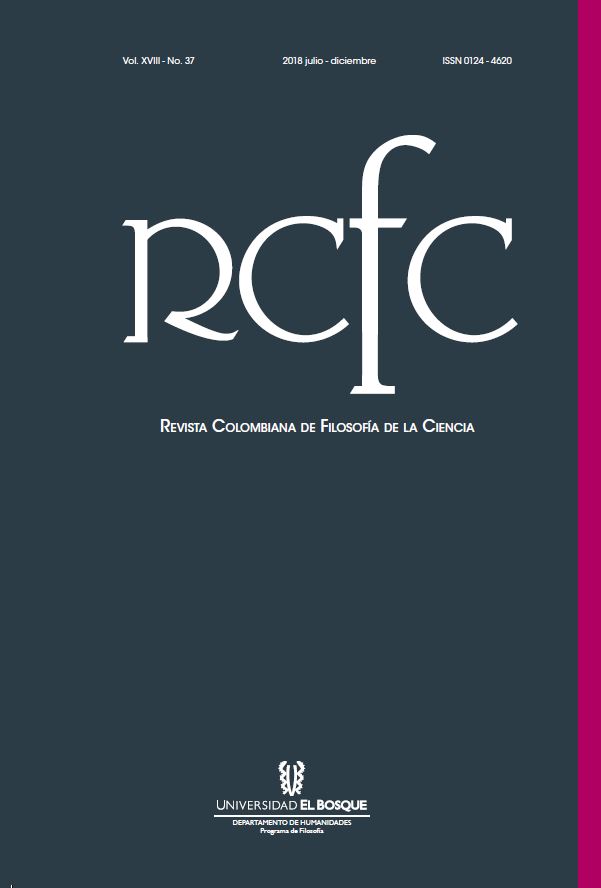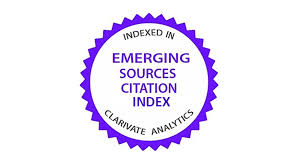Integración de analogías en la modelación científica
DOI:
https://doi.org/10.18270/rcfc.v18i37.2580Palabras clave:
modelación, modelación, representación científica, representación científica, analogía, analogía, impulso nervioso, impulso nervioso, modelo de Hodgkin y Huxley, modelo de Hodgkin y HuxleyResumen
La discusión sobre modelación científica se ha centrado en la relación representacional entre el modelo, como producto terminado, y un supuesto sistema diana en el mundo. Esta aproximación tiene algunos problemas para dar cuenta de procesos de modelación en los que aún está por definirse el objeto de la modelación. En este trabajo muestro que un análisis histórico de la modelación complementa el análisis representacionalista, ya que permite rescatar el proceso de integración de analogías que juega un papel en la generación de criterios de relevancia que permiten configurar el objeto de investigación. A su vez, esto apoya la tesis de que el análisis filosófico de algunas normas en la modelación requiere una reconstrucción histórica de cómo llegaron a instaurarse.
Descargas
Referencias bibliográficas
B. C. Abbott, A. V. Hill, y J. V. Howarth. “The Positive and Negative Heat Production Associated with a Nerve Impulse.” Proceedings of the Royal Society B: Biological Sciences 148.931 (1958): 149–87. <https://doi.org/10.1098/rspb.1958.0012>.
Cole, Kenneth, S. “Rectification and Inductance in the Squid Gian Axon”. The Journal of General Physiology 25.1 (1941): 29–51. <10.1085/jgp.25.1.29 >.
Gelfert, Axel. How to Do Science with Models. Springer, 2016. <https://doi.org/10.1007/978-3-319-27954-1>.
Godfrey-Smith, Peter. “Abstractions, Idealizations, and Evolutionary Biology”. Mapping the Future of Biology. Springer Netherlands, 2018. 47–56.
Hille, Bertil. Ionic Channels of Excitable Membranes. Second Edition. Sinauer Associates, 1992.
Hodgkin, A. L. “The Croonian Lecture: Ionic Movements and Electrical Activity in Giant Nerve Fibres”. Proceedings of the Royal Society B: Biological Sciences 148.930 (1958): 1–37.
Hodgkin, A. L. The Conduction of the Nervous Impulse. The Sherrington Lectures, Charles C Thomas, 1964.
Hodgkin, A. L., y Andrew F. Huxley. “The Components of Membrane Conductance in the Giant Axon of Loligo A”. The Journal of Physiology 116.4 (1952a): 473–96.
______. “A Quantitative Description of Membrane Current and Its Application to Conduction and Excitation in Nerve”. The Journal of Physiology 117.4 (1952b): 500–44.
Knuuttila, Tarja. “Modelling and Representing: An Artefactual Approach to Model-Based Representation”. Studies in History and Philosophy of Science Part A 42.2 (2011): 262–71.
Levy, Arnon. “Idealization and Abstraction: Refining the Distinction”. Synthese 1.1 (2018): 1–18.
Lillie, Ralph S. “The Passive Iron Wire Model of Protoplasmic and Nervous Transmission and its Physiological Analogues”. Biological Reviews 11.2 (1936): 181–209.
Meares, Patrick. “Flux Coupling and Nonlinear Membrane Phenomena”. Structure and Funciton in Excitable Cells. Eds. Chang, Donald C, Ichiji Tasaki, William J. Adelman y H R. Leuchtag. Plenum Press, 1983.
Massimi, Michela. “Perspectival Modeling”. Philosophy of Science 85.3 (2018) 335–359.
Mosgaard, Lars D., Zecchi K.A., Heimburg T. y Budvytyte R. “The Effect of the Nonlinearity of the Response of Lipid Membranes to Voltage Perturbations on the Interpretation of Their Electrical Properties. A New Theoretical Description”. Membranes 5.4 (2015): 495–512.
Peschard, Isabelle. “Target Systems, Phenomena and the Problem of Relevance”. The Modern Schoolman 87.3 (2010): 267.
Sanches de Oliveira, Guilherme. “Approaches to Scientific Modeling, and the (Non) Issue of Representation: A Case Study in Multi-Model Research on Thigmotaxis and Group Thermoregulation”. Model-Based Reasoning in Science and Technology. Eds. Lorenzo Magnani y Claudia Casadio. Springer, 2016. 79–100.
Seyfarth, Ernst-August und Leo Peichl. “Vor 100 Jahren: Julius Bernstein (1839-1917) Formuliert Seine Membrantheorie”. Neuroforum 4.2 (2002): 274–76
Tasaki, Ichiji. Physiology and Electrochemistry Nerve Fibers. Academic Press, 1982.
Tasaki, Ichiji, y Kunihiko Iwasa. “Rapid Pressure Changes and Surface Displacements in the Squid Giant Axon Associated with Production of Action Potentials”. Japanese Journal of Physiology 32.1 (1982): 69–81.
Teorell, Torsten. “Excitability Phenomena in Artificial Membranes”. Biophysical Journal 2.2 (1962): 25–51.
Weisberg, Michael. Simulation and Similarity: Using Models to Understand the World. New York: Oxford University Press, 2013.
Descargas
Publicado
Cómo citar
Número
Sección
| Estadísticas de artículo | |
|---|---|
| Vistas de resúmenes | |
| Vistas de PDF | |
| Descargas de PDF | |
| Vistas de HTML | |
| Otras vistas | |












